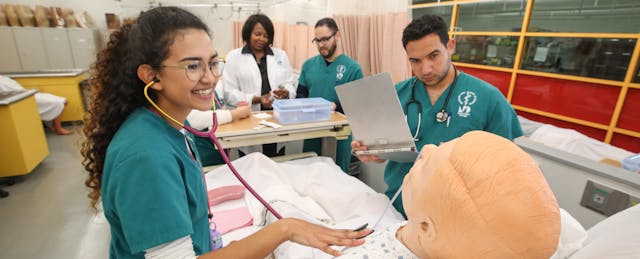Set a few miles from the sea and surrounded by swampy state parks, Indian River Community College was for years a lone outpost of higher education on Florida’s Treasure Coast. The nearest university—Florida Atlantic—was nearly 60 miles away, a long haul down I-95 for someone seeking more schooling but bound to her community by a home, a job, a family.
“To drive an hour-and-a-half one way to take a course at a university at night and back—it was just more than most families could handle,” says Edwin Massey, president emeritus of Indian River.
To help more Florida residents earn advanced credentials, the state expanded its university system in the early 1990s. The Treasure Coast region was in the running for a new institution—but the other side of the state won out.
People in the area started to wonder. They had a college down the street. Workers needed four-year degrees to get promotions. Hospitals needed nurses with management skills, and schools needed teachers trained in science and math. What, exactly, were they all waiting for?
“The question I got most was, ‘When will Indian River offer baccalaureate-level programs?’” Massey says.
It’s a query fielded by community college leaders across the country. And over the past three decades, they’ve answered the call for increased access to bachelor’s-degree pathways by creating them on their own campuses. In fact, some community colleges in Florida have been offering bachelor’s programs for 20 years, and now nearly two dozen states permit so-called two-year colleges to offer four-year degrees.
And the pace of adoption is speeding up, with half a dozen states signing on since 2018, according to the Community College Baccalaureate Association.
“I’m hopeful we’ll have another big jump this year and next year,” says association president Angela Kersenbrock. “We’re getting a lot of calls from legislators wanting to talk about it. Everybody is very concerned about higher ed equity.”
Not everyone in higher education is thrilled about what some leaders of four-year institutions see as competition for students. This spring, universities in Arizona are challenging a state bill that would empower community colleges to create bachelor’s programs.
But proponents say that embedding baccalaureate pathways within community colleges advances their mission to help all students succeed and local regions thrive—especially those people and places not well-served by other higher ed options.
“Most states, including Arizona, have goals for increasing the percentage of the population with a bachelor’s,” says Linda Thor, governing board member for Maricopa Community Colleges in Phoenix. “We are not ever going to reach those goals just continuing to do the same thing.”
The Benefits of a Bachelor’s Program
Most community college students say they want to earn a bachelor’s degree. Yet less than one-fifth do so within six years, according to the most recent data from the Community College Research Center.
One reason why, experts say, is that there’s a giant sinkhole blocking students’ path. It’s the requirement that they transfer from one institution to another. Too few community college students escape from that chasm, some higher ed leaders say, while their counterparts who start at bachelor’s degree institutions never have to face it at all.
“If you’re at a four-year school, nobody does a transcript review between your sophomore and junior year and says, ‘Sorry, we are not going to take your sophomore-year credits,’” says Josh Wyner, founder and executive director of the College Excellence Program at the Aspen Institute.
Embedding bachelor’s programs into the community colleges where students first enroll can help to eliminate that obstacle, proponents say. Such programs also tend to be more affordable than degrees from nearby public and private four-year institutions. For example, Miami Dade College in Florida offers several baccalaureate degrees starting at $10,000, according to president Madeline Pumariega. A credit hour there costs about $130, compared to about $200 at nearby public Florida International University.
And even if more students could successfully transfer to universities or afford higher tuition bills, some simply want to stay at the colleges where they start out.
“They tell us that if they could stay at their community college to complete their bachelor’s degree, they would do so,” Thor says. “They are smaller institutions. They are very student-focused. They are comfortable places.”

Competition For Students?
Twenty-five years ago, when Thor was president of Rio Salado College in Arizona, a chief of police came to her seeking help training more officers to move up the ranks.
“‘You do such a good job with the associate degree, can’t you do the bachelor’s degree?’” Thor recalls him asking.
So Thor set out to change the Arizona law that authorizes community colleges to offer programs of “up to two years.” She thought striking those four words from the record would be simple.
She was wrong.
“World War III broke out. It was one of the rare times you saw the private universities and the public universities join forces,” Thor says. “Back in 1996, we had no idea this would be such a controversial motion.”
Community colleges that aim to create a bachelor’s degree program face several challenges, such as stricter accreditation standards that may require hiring new faculty, expanding library services or raising money to improve facilities. Yet chief among the obstacles may be resistance from other higher ed institutions that fear new bachelor’s degree pathways will draw away students.
That’s what happened a quarter-century ago in Arizona, which is where a similar scene is now playing out again. This time, state universities successfully pushed for guardrails in proposed legislation that would permit community colleges to offer bachelor’s degrees, such as caps on tuition and the number of degrees offered. Meanwhile, those same state universities are still fighting the amended bill.
Yet community college leaders say they’re not interested in competition. The “applied bachelor’s degrees” they seek to offer are designed to fill gaps in the local labor force and lead people directly to open jobs in industries such as health care, cyber security, education and law enforcement—fields in which universities typically don’t offer training, or don’t produce enough graduates to meet the needs of local employers. For example, the dearth of credentialed child care workers in Illinois recently prompted state legislators to propose a bill that would allow community colleges to create bachelor’s programs in early childhood education.
Plus, many four-year programs created by two-year colleges are organized to accommodate the unique needs of working adults, who may already have an associate degree and may need to take classes part-time.
“You’re not trying to compete for the student directly out of high school,” says Pumariega of Miami Dade. “You are, in a sense, really working on that adult learner that needs to come back and finish that credential for a job or a promotion.”
Besides, advocates say, community colleges already champion open-access values and serve a distinct set of people: more older students, more students of color and more low-income students.
“When universities say, ‘We don’t want you to do this because you might take our students,’ I think there has to be a serious conversation around, ‘The fact is, you’re not taking these students now.’ Let’s roll up our sleeve and be honest there,” says Debra Bragg, a fellow at New America. “To me that’s what the community college baccalaureate is about: to hold the system accountable to access and outcomes.”
‘Somebody’s Got to Do It’
Data about the outcomes of community college bachelor’s pathways do indeed look promising so far.
About 20,000 baccalaureate degrees were awarded in 2018-2019, according to analysis by the American Association of Community Colleges. A study from New America shows that Florida’s community college baccalaureate programs graduate students nearly as diverse as the state’s population—although Latinx people are a bit underrepresented. A high percentage of graduates were older than 30, in contrast to the mostly younger students graduating from the state’s four-year institutions.
“These programs are an important access point for students who may not enroll in a bachelor’s program at a university,” says Ivy Love, the study author and a senior policy analyst.
The programs also seem to pay off. Research from Washington shows that graduates of the state’s community college bachelor’s programs start out with higher wages than their counterparts who graduate from university programs. And Florida graduates earned about $10,000 more annually than their peers who only have associate degrees in similar fields.
“In some ways, that’s expected, but it’s also showing that the institution of a community college can guide a student through a bachelor’s program and they still reap economic benefits,” Love says. She notes, however, that this wage premium does vary by race, ethnicity and gender.
Getting more people access to better-paying jobs is a stated priority for leaders of all political persuasions. And the notion that community colleges can help accomplish that, through their own baccalaureate programs, is catching on.
A decade ago, Wyner of the Aspen Institute—which gives awards to outstanding community colleges—thought it was a bad idea. Now, he says, his view has evolved.
“We need more bachelor’s degrees in regional economies,” he says. “Somebody’s got to do it on the public side. If the four-years won’t do it, we’ve got to think of other solutions.”
That’s what leaders at Indian River Community College believed two decades ago. They spent about seven years preparing to offer applied baccalaureates in nursing, education and business, a process that included discussing their plans with Florida university leaders.
“It ended up being a very healthy conversation, a good conversation,” says Massey, who was president of Indian River at the time.
The college won state approval for new programs in 2007. Soon after, it unveiled a new name: Indian River State College.
More people in the area—including racial minorities—started earning higher degrees. The increase in skilled workers attracted biotechnology, digital media, and accounting companies to set up shop.
The Treasure Coast transformed from a higher ed desert to an oasis.
“A baccalaureate degree becomes the measurement of economic stability within a community,” Massey says. “Once this became the norm, then it became a magnet to help us with economic development.”
Indian River State College has graduated about 8,000 people with bachelor’s degrees, according to Massey. That helped the college win the $1 million Aspen Prize for Community College Excellence in 2019—an honor it shared with a fellow Floridian, Miami Dade College.
Many of its bachelor’s students are parents, and people of color, and part-timers—neighbors seeking better jobs right where they already live, in between the marsh and the beach.
“It’s a different body of students who are looking for this opportunity,” Massey says. “That’s what community colleges do.”


